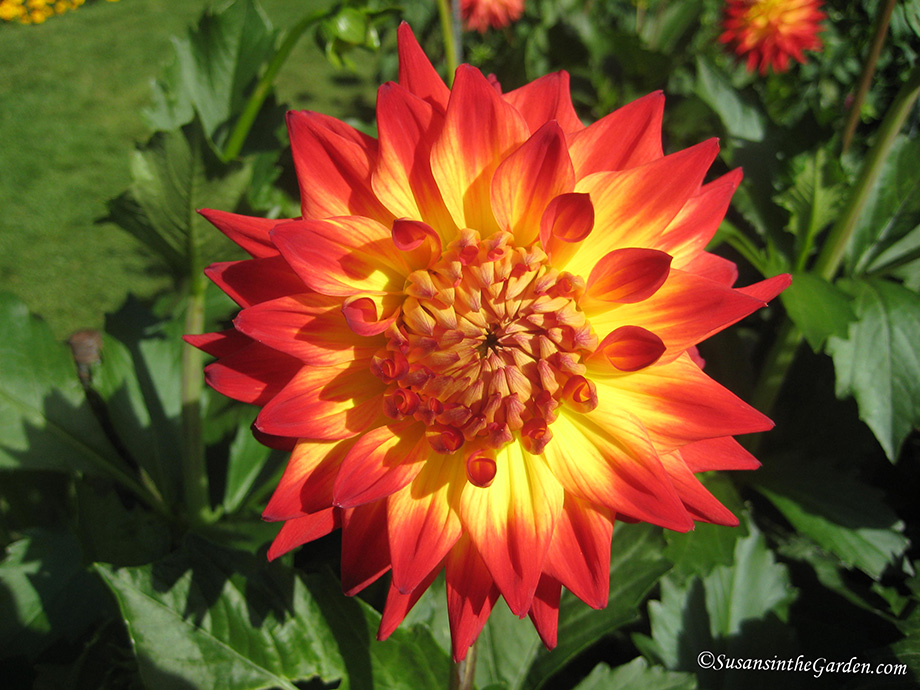Sept. 12 Column: Overwinter Dahlia Tubers

Remember how I grew dahlias this year, for the first time in ages? Well, our growing season is coming to a rapid close so I thought a column about how to overwinter dahlia tubers would be helpful. You can read my column in today’s edition of The Spokesman-Review: Dahlias worth the extra effort needed to overwinter tubers. (or you can read the text of my column underneath the video below)
I grew five dahlias this year and I have really enjoyed those beautiful flowers. Since I want to grow them again next year, that means I need to know how to overwinter dahlia tubers. Since I’m new to this, I decided to consult with Nicki Farrell, who owns Tall Grass Farms in Medical Lake, Wash. She and her husband Scott grew over 8,000 (wow) dahlias this year so I figure she knows what she’s doing!
Nicki was probably a little hesitant to share their methods — not because she didn’t want me to be successful but because she knows there are many different ways to overwinter dahlia tubers. And I’m fully expecting to receive emails from other dahlia experts, telling me they have success with a different method. Well, that’s OK. Bring them on!
I also wanted to mention that Nicki and Scott have a photo tutorial of the process on their Facebook page. Be sure to check it out. She told me they usually do a Facebook live video each fall to show folks firsthand how to do this. If you follow their Facebook page, you’ll know when it will take place.
For this week’s video, I demonstrated the third and final pruning that I subject my tomato plants to, in order to get those last green tomatoes to ripen. This time, it’s really drastic but it works!
And here is my column:
By Susan Mulvihill
For The Spokesman-Review
This summer, I grew dahlias for the first time in years. The flowers have been gorgeous and they did well, considering all of the challenges thrown their way.
First, the quail nibbled the new sprouts as soon as they came up. One of my dahlias decided that was the ultimate insult and never sent up more shoots. I caused another problem by planting sunflowers in the same bed, without realizing their massive leaves would shade the dahlias too much.
When the heatwave hit in late June, they required a lot more water. The plants still bloomed for me but I had the sense they were saying, “You expect us to flourish under these conditions?”
Now that fall is rapidly approaching, I want to overwinter the tubers so I can grow them again next year. I’ve promised the plants better conditions next year but want to get this step right.
Because I am a novice, I consulted with Nicki Farrell who, with her husband Scott, grows thousands of dahlias at Tall Grass Farms in Medical Lake. There are many different methods for digging and overwintering tubers but I figure they know what they’re doing.
“There are many ways but taking your specific local climate into account is crucial since most online directions are geared more for coastal weather,” she told me.
Nicki and Scott dig their tubers when they are ready, rather than letting the frost dictate when that happens.
“If we frost early, we dig as soon as they are frozen because, at that point, the dahlias are done,” she said. “In that rare year we make it longer, we cut down the plants toward the end of September because, in October, the weather can really take a turn for the worse.”
As you can imagine, digging up thousands of tubers is a monumental process. She and Scott only dig up what they can process in a single day. This involves digging, washing the tubers, dividing them and packing them away.
“Digging and letting them sit will basically either shrivel up the tubers or turn them limp, floppy tubers like leaving a carrot out of the crisper,” Nicki explained. “I hear a lot of people dig their tubers and let them sit out for a few days to dry, but that actually destroys them.”
After washing and dividing the tubers, they only let them sit out for 15 to 30 minutes on a sunny day, until they are dry to the touch.
“We then pack the tubers in shavings and store them in plastic bags or bins,” she continued. “We take them to our storage room, which is 40 to 45 degrees F., and we keep it dark for the first few weeks. It’s normal to see condensation build-up due to the fluctuating temperatures. If it’s too much, we vent the bags a bit or even swap the tuber to a new bag with new shavings. After a month, they check the tubers and if all is well, they should make it through the rest of the storage period.”
Nicki doesn’t want gardeners to get discouraged if they don’t have luck storing the tubers.
“Don’t stray away from dahlias because of the storage process,” she advised. “Many tubers can be bought for about the same price as annual plants and there is no shame in growing them, leaving the plants in place and buying new tubers the next season. It’s no different than buying your favorite petunias.”
Susan Mulvihill is author of “The Vegetable Garden Pest Handbook.” She can be reached at Susan@susansinthegarden.com. Watch this week’s “Everyone Can Grow a Garden” video at youtube.com/susansinthegarden.

